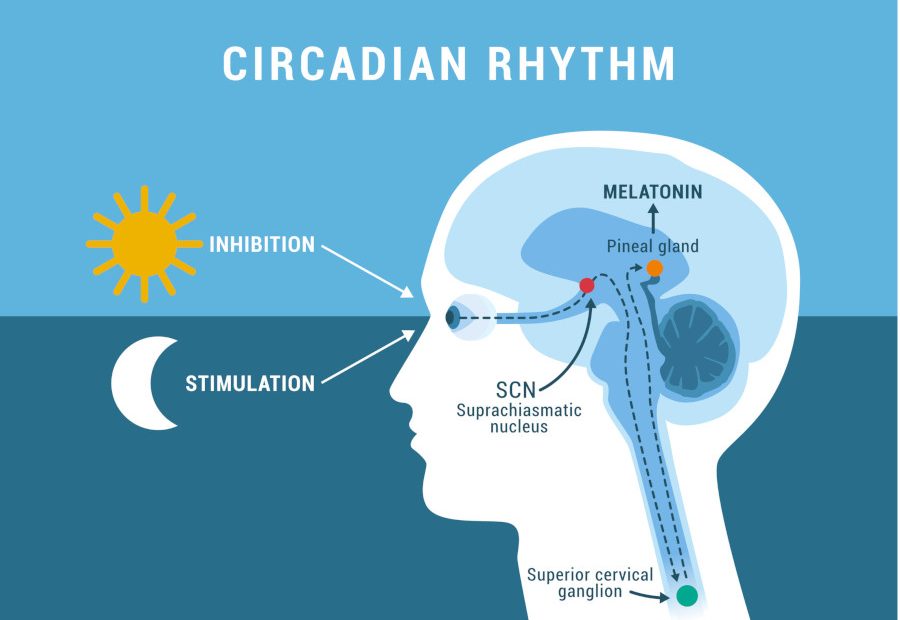The circadian rhythm is a natural, internal process that regulates the sleep-wake cycle and various other physiological and behavioural processes in living organisms, including humans. The term “circadian” comes from the Latin words “circa” (meaning “around”) and “diem” (meaning “day”), indicating that these rhythms have a roughly 24-hour cycle. These rhythms are driven by an internal biological clock, which is influenced by external cues, most notably the daily light-dark cycle.
Key features of the circadian rhythm include:
- Sleep-Wake Cycle: The most well-known circadian rhythm is the sleep-wake cycle, which helps regulate when we feel alert and when we feel sleepy. The circadian clock promotes wakefulness during the daytime and sleep at night.
- Body Temperature: Core body temperature follows a circadian pattern, peaking in the late afternoon and reaching its lowest point during the early morning hours. This temperature rhythm can influence alertness and cognitive function.
- Hormone Production: Various hormones, including melatonin and cortisol, are regulated by the circadian rhythm. Melatonin, for instance, increases in the evening, signaling the body to prepare for sleep, while cortisol levels rise in the morning, promoting alertness.
- Metabolism: The circadian rhythm also affects metabolic processes, including digestion and the release of insulin. Eating at irregular times can disrupt these rhythms and may contribute to health issues like obesity and metabolic disorders.
- Cognitive and Physical Performance: Cognitive functions, such as memory, attention, and reaction times, tend to be at their best during the daytime when the circadian clock promotes wakefulness. Physical performance and muscle strength also have daily variations.
- Mood and Emotions: Circadian rhythms can influence mood and emotional well-being. Disruptions to the circadian clock, such as those experienced by shift workers, can lead to mood disorders and increased risk of depression.
- Organ Function: Various organs and systems in the body have circadian variations in their function, which can impact how they respond to medications and external factors. For example, the liver’s metabolic activity follows a circadian pattern.
The primary driver of the circadian rhythm is the suprachiasmatic nucleus (SCN), a cluster of nerve cells in the hypothalamus of the brain. The SCN receives input from the eyes, which helps synchronize the internal clock with external light-dark cycles. However, other cues, such as temperature, feeding patterns, and social interactions, can also influence circadian rhythms.
Disruptions to the circadian rhythm, such as those caused by jet lag, shift work, or irregular sleep patterns, can lead to various health issues and impair daily functioning. Maintaining a consistent sleep schedule and exposure to natural light during the day can help regulate and align your circadian rhythm for better health and well-being.
References
Clayton Vasey, Jennifer McBride, Kayla Penta. Circadian Rhythm Dysregulation and Restoration: The Role of Melatonin
-https://pubmed.ncbi.nlm.nih.gov/34684482/
R M Voigt, C B Forsyth, S J Green, P A Engen, A Keshavarzian. Circadian Rhythm and the Gut Microbiome
-https://pubmed.ncbi.nlm.nih.gov/27793218/
Alan M Rosenwasser, Fred W Turek. Neurobiology of Circadian Rhythm Regulation
-https://pubmed.ncbi.nlm.nih.gov/26568118/
Ana R Neves, Tânia Albuquerque, Telma Quintela, Diana Costa. Circadian rhythm and disease: Relationship, new insights, and future perspectives
-https://pubmed.ncbi.nlm.nih.gov/35696609/
Siegfried Wahl, Moritz Engelhardt, Patrick Schaupp, Christian Lappe, Iliya V Ivanov. The inner clock-Blue light sets the human rhythm
-https://pubmed.ncbi.nlm.nih.gov/31433569/
This article is copyrighted by Ital is Vital, 2025. Want to re-post this article? Visit our guidelines.
DISCLAIMER: THIS WEBSITE DOES NOT PROVIDE MEDICAL ADVICE
The information, including but not limited to, text, graphics, images and other material contained on this website are for informational purposes only. The purpose of this website is to promote broad consumer understanding and knowledge of various health topics. It is not intended to be a substitute for professional medical advice, diagnosis or treatment. Always seek the advice of your physician or other qualified health care provider with any questions you may have regarding a medical condition or treatment and before undertaking a new health care regimen, and never disregard professional medical advice or delay in seeking it because of something you have read on this website.
